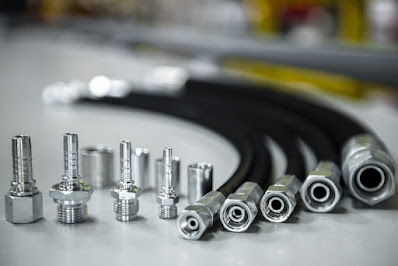Hydraulic hose couplings play a pivotal role in facilitating fluid transfer within various industries, ranging from manufacturing and construction to agriculture and automotive. These essential components are integral to the seamless operation of hydraulic systems, ensuring efficient power and fluid transmission within machinery and equipment.
This comprehensive guide will delve into the diverse types of hydraulic hose couplings, shedding light on their unique functions and applications across different industrial contexts.
Types of Hydraulic Hose Couplings
Hydraulic Quick Disconnect Couplings
Hydraulic quick disconnect couplings, also known as quick couplers, are designed to provide rapid and efficient connections and disconnections in hydraulic systems. These couplings consist of a male and female component, enabling swift and secure attachment and detachment of hoses. Their versatility and ease of use make them invaluable in applications where frequent connections and disconnections are necessary, such as in agricultural machinery, construction equipment, and hydraulic tools.
Hydraulic Camlock Couplings
Camlock couplings, characterised by their cam-and-groove design, offer a simple yet robust means of connecting and disconnecting hoses. These couplings are widely favoured for their rapid and leak-free connections, making them ideal for applications requiring frequent hose changes or where spillage needs to be minimised. Their common uses span industries such as petrochemical, mining, and water management, where efficient fluid transfer is paramount.
Hydraulic Flange Fittings
Flange fittings in hydraulic systems provide a secure and leak-resistant connection between hoses and hydraulic components. These fittings utilise flat, interconnected surfaces bolted together, ensuring a robust and reliable connection. Hydraulic flange fittings are often preferred in high-pressure applications, including heavy machinery, marine systems, and industrial processing, where the integrity of the hydraulic connections is critical.
Hydraulic Screw-to-Connect Couplings
Screw-to-connect couplings, also known as threaded couplings, are designed with a threaded mechanism for connecting hoses to hydraulic equipment. These couplings offer a secure and durable connection, making them suitable for high-pressure and vibration applications. Industries such as aerospace, automotive, and manufacturing often rely on screw-to-connect couplings for their resilience and ability to withstand demanding operating conditions.
How Hydraulic Coupling Works
A. Basic Principles of Hydraulic Coupling Operation
Hydraulic couplings facilitate the seamless transfer of pressurised fluid within a hydraulic system. The fundamental principles governing their operation involve the creation of a sealed pathway when connected, allowing fluid to flow and enabling the transmission of both power and control signals. The meticulous selection of the appropriate coupling is paramount, directly influencing the hydraulic system’s efficiency, performance, and overall reliability.
Understanding the basic principles involves recognising how hydraulic couplings create a secure connection. As the coupling is engaged, it forms a sealed junction that acts as a conduit for the fluid. This sealed pathway is essential for maintaining the integrity of the hydraulic system, ensuring that pressurised fluid can travel unimpeded, ultimately facilitating the transfer of power and control signals to various components within the system.
B. Factors Affecting the Performance of Hydraulic Couplings
In the realm of hydraulic systems, the performance of couplings is subject to various influential factors, each playing a crucial role in maintaining optimal functionality. Among these factors, pressure stands out as a significant determinant. The hydraulic coupling must withstand the pressure exerted by the fluid to prevent leaks and ensure a consistent flow. Therefore, a thorough understanding of the operating pressure conditions is essential when selecting an appropriate coupling.
Temperature is another critical factor influencing hydraulic coupling performance. Extremes in temperature can impact the material properties of the coupling, potentially leading to degradation or failure. Couplings must be selected based on their compatibility with the temperature range they will encounter during operation, ensuring durability and reliability.
Furthermore, the compatibility of hydraulic couplings with specific fluids is a vital consideration. Different fluids exhibit varying chemical compositions and properties, and the coupling material must be compatible to avoid deterioration or corrosion. Careful attention to fluid compatibility contributes significantly to the longevity and effectiveness of hydraulic hose couplings.
In addition to these factors, regular and proper maintenance practices are indispensable for ensuring the sustained performance of hydraulic couplings. Adherence to safety standards is equally paramount to mitigate risks and extend the overall lifespan of the hydraulic system. The collective consideration of these factors underscores the importance of a holistic approach to maintaining hydraulic coupling performance, promoting longevity, and safeguarding the efficiency of the hydraulic system.
Considerations for Choosing the Right Hydraulic Hose Coupling
Selecting the appropriate hydraulic hose coupling entails carefully considering various factors, including the application’s specific requirements, compatibility with fluids and environmental conditions, and safety and industry standards. It is imperative to prioritise compatibility, durability, and adherence to regulatory guidelines when choosing hose couplings to ensure optimal performance and safety.
Conclusion
Understanding the diverse types of hydraulic hose couplings and their functionalities is paramount for individuals and businesses seeking to optimise the performance of their hydraulic systems. By delving into the nuances of hydraulic couplings and their applications, readers can make informed decisions when selecting the most suitable couplings for their unique operational needs. For further guidance and tailored recommendations, we encourage readers to explore additional resources or consult with industry professionals like Austfluid Link Asia Pacific to address their specific hydraulic coupling requirements.
In conclusion, the comprehensive guide presented here aims to equip readers with the knowledge and insights necessary to navigate the realm of hydraulic hose couplings with confidence and efficacy.


